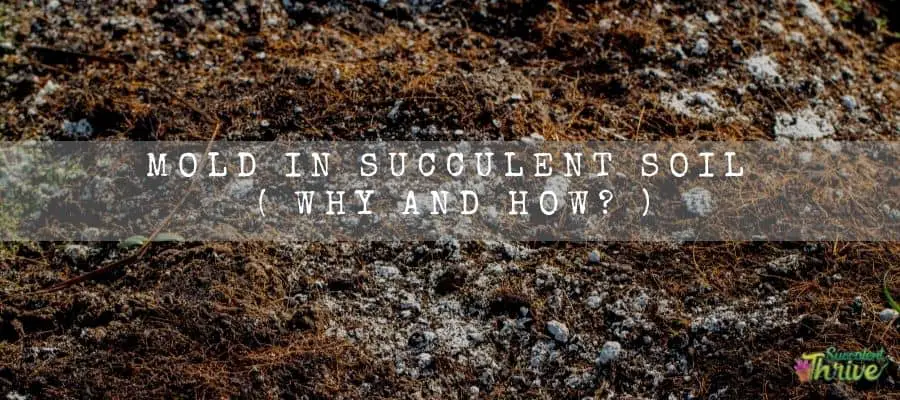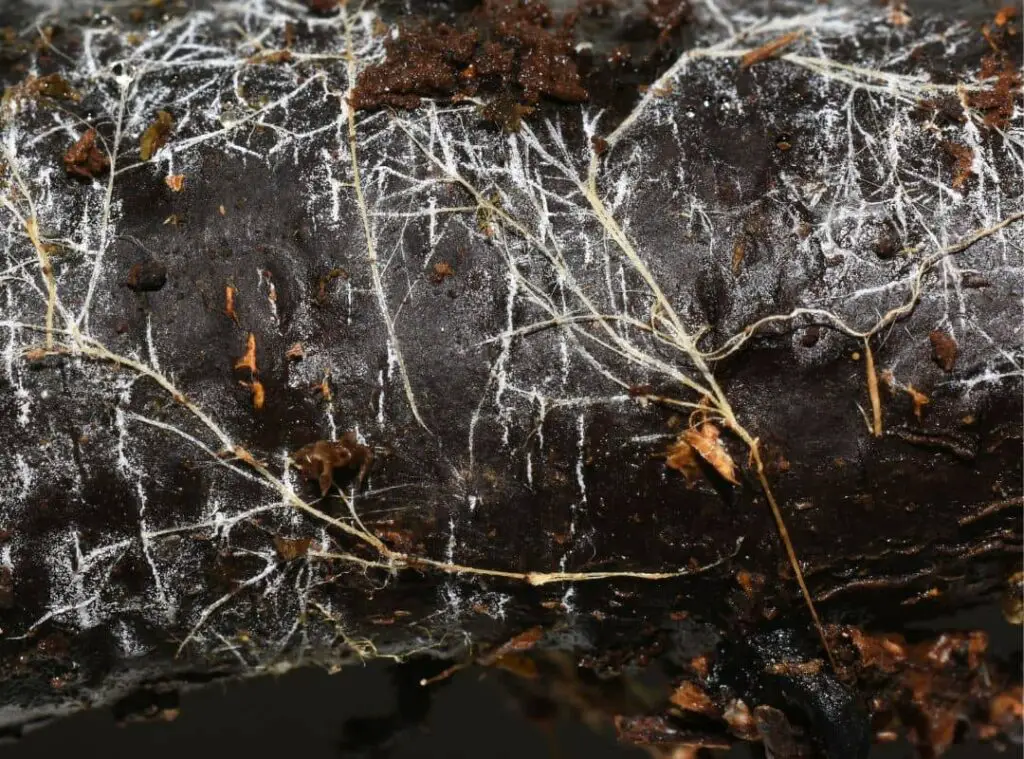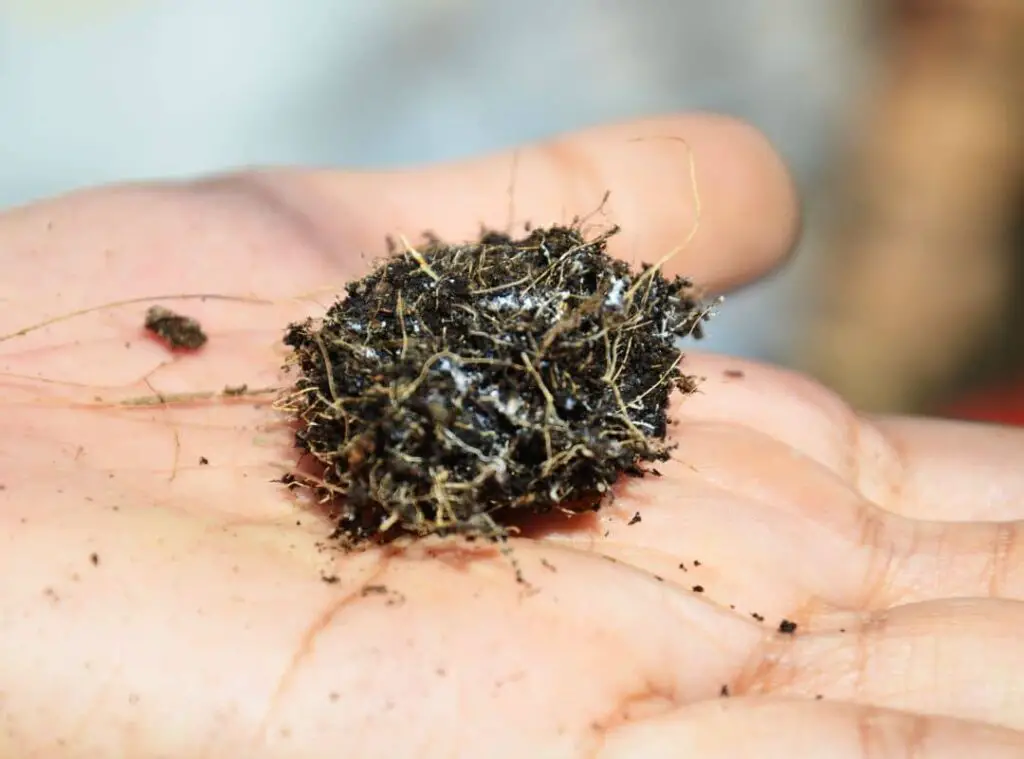Do you know not all mold in succulent soil is beneficial for the plant’s health? Pathogenic fungi are those that cause disease in plants and humans. I found that the hard way. I had to see some of my lovely plants die because of this dangerous disease.
Fungicides is the easiest solution to get rid of mold in succulent. you can use either DIY fungicides or commercial fungicides. Neem oil, milk spray, baking soda mixtures, and mouthwash are examples of homemade fungicides. But the best solution is the prevention. To do that you can try to remove diseased plants, improve soil condition and fix the reason.
In this article, I will present in-depth guidance on the root causes of succulent soil molds and the modes of getting rid of them. So, I urge you to read this article since it will give you insight on this subject.

Why is there mold in succulent soil?
There are few factors which would cause this condition. For example, excess watering, unhealthy soil, lack of oxygen in soil, lack of sunlight and poor maintenance are some of the prominent causes which could cause this condition.
Having said that, fungi is a crucial aspect of healthy soil. It is what sequesters carbon. Further, that is responsible for the decomposition of the organic matter also. Once the soil decomposes, it would allow the plants to absorb the nutrients.
01. Too much water
The occurrence of mold in succulent soil is natural. Typically, fungi spores rest and dormant in soil for years. So, when they get favorable conditions for them, it will be like a wake up call for them. So out of all these, the excess water in the soil is a prime factor that would cause soil molding. So, avoid overwatering the plants.
Further, when you water, you need to angle the hose without letting the plant get wet. Moreover, do not spill water on the plants’ leaves, as that would moisten them. Instead, try to water the plant’s base directly. The growth of the mold can take place whenever there is moisture available on any surface. Usually, mold takes place from the spores, and whenever they land on any surface, they become mold at the end.
Whenever the perfect surroundings are available for them, they become active. As you may already know, succulents have water conserved in their bodies, and they are not the type of plants that would absorb water in excess. So, if you supply a lot of water for them, it will lead to the sogginess and dampness of the soil, which would pave the way for mold development in the soil.
02. Unhealthy soil
When I say unhealthy soil, one might think that I am referring to soil mixes that have bacteria and fungi. No, you still want some percentage of healthy bacteria and mold in succulent soil, as they would be more like bodyguards and protect the plants from pathogenic fungi. However, consider that if the microorganisms in your soil are imbalanced, there is a high probability that pathogenic fungi will be more active in the microbiome.
If you are wondering what would pave the way for unhealthy soil , it would be mainly a repercussion of using pesticides. So, to overcome this challenge, you may consider using organic no dig gardening methods. However, if you practice these tips and still if you come across these, chances are that what you used to grow the succulents is already contaminated. So, be mindful to choose a soil mix which is sterile.
03. less oxygen in soil
Consider that your soil mix doesn’t have sufficient oxygen. Then those would be ideal conditions for pathogenic fungi as well as pathogenic bacteria. In simple words, they would be perfect breeding places for these pathogenic organisms. Ultimately, the healthy bacteria would find it difficult to combat the harmful pathogenic microscopic organisms, and the pathogenic organisms would be more dominant in the soil mix.
Ideally, you need to increase the air circulation in the soil. Do not wait until things get out of hand; act smartly and swiftly to overcome them well in advance. Unless there will be major and severe repercussions, which would be fatal to your precious succulents. Try to avoid using heavy machinery whenever possible, which would also be a cause that would result in this condition.
Further try to cover the crops also so that it would protect the barre soil from rainfall. In addition to that you may also make use of a rototiller which would be ideal to deal with these kinds of conditions. However, it would make leaves a compaction layer in the soil.
04. Lack of sunlight
Lack of sunlight is one more common reason that would contribute to mold in succulent soil. Succulents are sunlight fan lovers. If you have cultivated them outdoors, they need to have at last six hours of sunlight. On the other hand, if you have cultivated them indoors, ensure that you place them in a bright, sunny spot. Literally, it has to be the brightest spot in your home. So, if your beloved plants are deprived of adequate sunlight, it would literally pave the way for mold buildup in the soil.
05. Poor maintenance
You need to provide minor maintenance and supervision to grow the succulents. However, you must still devote some time and care to them in order for them to grow well and be healthy. If you continue to neglect your plants and allow them to grow without any care or treatment, pathogenic fungi will find those conditions quite appealing. When I say poor maintenance, that includes the lapses in watering, poor lighting, and lack of cleaning as well.

How do you get rid of mold in succulent soil?
Prevention is better than cure. Keeping this in mind, I believe the best course of action is to implement all preventive measures that will help you avoid the growth of pathogenic molds in your soil. If you just act normally and let the fungus take over your plants, and after some time, if you wish to apply fungicides, it will only create more trouble for you and for the plants as well.
The more elements you add to kill the harmful organisms, the more the beneficial organisms will kill. Healthy organisms are quite crucial for the health of the soil. So, if you apply too many fungicides, that would also be badly affected. To reiterate, not all fungi are harmful to plants. However, if you come across any white fuzziness in the soil, that literally means the soil is under attack by pathogenic fungi, and you need to act swiftly to overcome them.
So, the following is how you should get rid of the fungus.
01. Remove diseased plant part
The very first thing you could do to overcome mold in succulent soli is to remove the deceased plant parts. However, it would depend on the severity of the fungi that have attacked your beloved plants and the soil. If the mold attack has spread on a minor level, you may simply snip off the diseased leaves or any other parts of the plants.
Furthermore, I recommend you remove some healthy leaves, which would allow the plants to have more aeration. However, keep in mind to not cut off 30% of the leaves, as that would badly affect the photosynthesis process of the plants.
02. Improve condition
In addition to that, if there are lapses in the growing conditions, it would also lead to mold in the soil. So, considering that the succulent soil is waterlogged, I suggest you repot the plants. In addition to that, you may also place them in the open greenhouse. However, keep in mind to open the doors so that there will be more air coming in.
Apart from that, I suggest you rotate the pacing of the plants where you have cultivated them. It would also help the plants overcome any occurrence of pests, diseases, or mold. Furthermore, never spill water on the leaves of the plants. If you accidentally do so, take very good care of the soil.
Go ahead with a top-quality compost, which will ensure that there are no microorganisms established in your soil. Furthermore, if you consider that you have used a lot of fungicides, chances are that they have killed many beneficial organisms in the soil mix.
03. Fix the reason
If you could spot mold in your succulent soil, that literally means something is not right in the soil mix. Ideally, you need to apply an excellent compost or even compost tea to do this task. I suggest you suspend applying fungicides and observe what exactly has gone wrong in your plants. Try to figure out the root cause of that.
You may think, you will have to spend more time to rectify these. However, if you put some time and effort into it and try to identify the root cause, it will be simple to remedy them. Unless you imagine how challenging it would be to deal with these fungi for so long. Bear in mind that it would be cost effective also as you do not have to spend so much money on purchasing the fungicides etc.
04. Fungicides
Applying fungicides is not always bad. There are times when you have to make use of them at some point. If you spot fungi in the soil even after taking good care of them, I suppose using fungicides periodically would be a great solution here.
Keep in mind that you need to apply the fungicides based on the symptoms you can witness. I recommend you save your pants by using pet- and human-friendly fungicides if the requirement arises. Having said that, you must still determine what root cause allowed the pathogenic mold to grow.
Will vinegar kill fungus in soil?
You could use vinegar to kill the fungus in the soil. However, chances are that it may badly affect the overall health of the succulents as well. Keep in mind that the succulents that are battling mold are somewhat weak when compared with the healthy plants.
So, if you end up using vinegar and let them get in contact with the plants, it will badly affect the plants too. That being said, if you must choose between vinegar and chemical fungicide, I believe vinegar is the better option. Vinegar is cost-effective, and it has less effect on the health deterioration of the plant when you compare it with the inorganic chemical fungicides.
Will baking soda kill fungus in soil?
Yes, baking soda will kill fungi in the soil that have spread in significant numbers. However, I recommend using them as foliar sprays. That said, if your succulent’s soil is going through these conditions on and off, I recommend you proceed with using baking soda. Bear in mind that baking soda does not have the same consequences for plants as chemical fungicides do.
If you wish to use baking soda, you may first fill a spray bottle with water. Next, mix a few drops of vegetable oil into it. After that, add a teaspoon of baking soda and stir it well. Now is the time for you to spray it on the plants as well as on the soil. However, chances are that it may even be fatal for the beneficial fungi in the soil too.
Will bleach kill fungus in soil?
You could use bleach to kill the fungus in the soil too. Bleach is mainly used for sterilization purposes. This literally means that it would kill the bacteria and fungi as well.
Does boiling water kill the fungus?
To answer the question first, Boiling water does kill the fungus in the soil. You may simply take the contaminated soil and pour boiled water into it. Once you use sufficient boiling water, the soil would be sterile, which you could use for potting purposes. That said, bear in mind that boiling water may eradicate the essential nutrients of the plants as well.

Related questions
Is mold in plant soil harmful?
To answer the question whether the mold in plants would be harmful, no it is not. Usually mold, fungi are prevalent in the soil mixes
Can You Test Soil for Fungus?
Yes, you can test soil for fungus. In fact, you need to regularly check for fungus, and it should be a part of your gardening activities. There are test kits that you could use to do this at home. However, they are not the best as you cannot really rely on the results they give. So, it would be better if you could just consult your local experts and see whether they have any soil testing program which you can afford.
In addition to that, you may also send a sample of your soil to a soil technician and get that checked. There could be different labs that practice different approaches, so ensure that you select someone who has gained recognition for their work. However, when you send the sample, ensure that you send it in aerobic conditions unless it would give you inaccurate results.
Further, if you find out there are normal pathogenic spores in the soil mix, you may just ignore that as it is quite normal. However, if you found out that there are other microorganisms , that would be attractive for the other harmful fungi.
How Do I Identify the Different Types of Mold?
You could identify the different types of mold by simply looking at them. So, to summarize, soil fungus appears in the form of white stringy clumps. There are numerous types of mold that you may come across.
- Leaf spot is a commonly spotted mold type, and you could see them as spots which are discolored. They would most probably be either yellow or brown. If you come across any, I suggest you remove the infected parts. If it keeps spreading, you need to treat them more.
- Powdery mildew and garden fungus are two more mold types which you may come across. Powdery mildew will appear on the leaves first.
- Some of the garden fungus are anthracnose, blight, rust, clubroot etc. Anthracnose, will appear to be black stains on the leaves. You could spot blight as brown spots on your plants.
- On the other hand , you could identify rust as roundish blisters on the stems. Lastly, you could clubroot by observing the plant roots. They would be mutated and swollen once they suffer from clubroot.
Conclusion
Before you treat the fungus in your succulent soil you need to identify what kind of fungus you are dealing with as chances are that they could either be beneficial or harmful too. So, if you figure out that pathogenic fungi have formed here, you need to act smart and try to eradicate them. To do that, you need to water the plants moderately and let the beneficial microorganisms perform their functions also.
Read Next : Austrocylindropuntia Subulata Dying (9 Important Facts)
